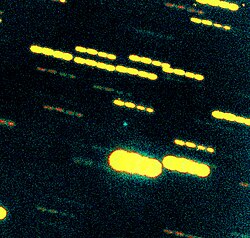Comet Wirtanen
 |
|
| Discovery | |
|---|---|
| Discovered by | Carl A. Wirtanen |
| Discovery date | January 17, 1948 |
| Alternative designations |
1961 IV; 1960m; 1967 XIV; 1967k; 1974 XI; 1974i; 1986 VI; 1985q; 1991 XVI; 1991s; 46P/1948 A1; 1947 XIII; 1948b; 46P/1954 R2; 1954 XI; 1954j |
| Orbital characteristics A | |
| Epoch | September 3, 2002 (JDT 2452520.5) |
| Aphelion | 5.129946 AU |
| Perihelion | 1.0587602 AU |
| Semi-major axis | 3.0943529 AU |
| Eccentricity | 0.6578412 |
| Orbital period | 5.44 a |
| Inclination | 11.73813° |
| Earth MOID | 0.068 AU (10,200,000 km) |
| Last perihelion | July 9, 2013 February 2, 2008 |
| Next perihelion | 2018-Dec-12 |
46P/Wirtanen is a small short-period comet with a current orbital period of 5.4 years. It was the original target for close investigation by the Rosetta spacecraft, planned by the European Space Agency, but an inability to meet the launch window led to Rosetta being sent to 67P/Churyumov–Gerasimenko instead. It belongs to the Jupiter family of comets, all of which have aphelia between 5 and 6 AU. Its diameter is estimated at 1.2 kilometres (0.75 mi).
46P/Wirtanen was discovered photographically on January 17, 1948, by the American astronomer Carl A. Wirtanen. The plate was exposed on January 15 during a stellar proper motion survey for the Lick Observatory. Due to a limited number of initial observations, it took more than a year to recognize this object as a short-period comet.
The 2013 perihelion passage was not favorable, only reaching a magnitude of 14.7. Since between January 23 and September 26, the comet had an elongation less than 20 degrees from the Sun.
On 16 December 2018 the comet will pass 0.0777 AU (11,620,000 km; 7,220,000 mi) (~30 LD) from Earth, reaching an estimated magnitude of 3 to 7.5, making this pass the brightest one predicted, and the brightest for all other future upcoming passes.
The comet was the target for the proposed 2016 Comet Hopper mission, which reached the finalist stage in the Discovery program. It was one of only three missions in that selection to have a more detailed study. The selection process was ultimately won in 2012 by the InSight mission, a Mars lander. The Comet Hopper was designed to use the ASRG, the Advanced Stirling Radioisotope Generator.
...
Wikipedia
